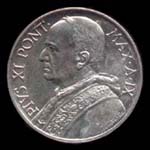




- Chronology
- Coins (1929 - 1938)

Achille Ratti was born in 1857 at Desio, near Milan, in a family of silk manufacturer. He studied in Milan and at the Gregorian University, in Rome, and was ordained a priest in 1879. He taught in the Milan seminary, in 1888 was appointed as one of the college of doctors of the Ambrosian Library in Milan, and in 1907 he was made chief librarian. Called by Pius X to Rome, he became vice prefect of the Vatican Library. In 1918, Benedict XV entrusted him with the legateship in Poland. Two years later the Pope appointed him archbishop of Milan and created him cardinal. On February 6, 1922 he was elected pope as successor of Benedict XV.
Pius's pontificate was marked by great diplomatic activity, in which he was aided at first by Pietro Gasparri and after 1930 by Eugenio Pacelli, who succeeded him as Pius XII. In 1929 Cardinal Gasparri signed the Lateran Treaty between the Holy See and the Italian government, represented by Benito Mussolini. The treaty solved the so called Roman Question, born in 1871, when the unity of Italy was perfected by restricting the papal sovereignty to a few buildings and awarding to the Vatican an annual indemnity for the lost Papal States. The Roman Catholic Church never recognized this arrangement up to the recognition of the new state of the Vatican City. Nevertheless, the Fascist government and the pope were in open disagreement over the restriction of the activities of the Catholic Action; this culminated in a strong papal letter (Non abbiamo bisogno, 1931), showing the impossibility of being at once a Fascist and a Catholic.
In 1933 Cardinal Pacelli negotiated a concordat with the Germany of Adolf Hitler. In 1937, due to the interference by the Nazis in Catholic life, the pope denounced the government and the Nationalist Socialist theory in the encyclical Mit brennender Sorge. A few days later he issued a definitive analysis of Communism from the Roman Catholic point of view in Divini Redemptoris. He spoke out continually against nationalism, racism, and totalitarianism and their menace to human dignity. In his encyclical Quadragesimo anno (1931) the pope urged social reform especially renewing the plea made 40 years earlier by Leo XIII.
Pius took delight in new technological developments. He established a broadcasting station at the Vatican and advanced the modernization of the Vatican Library. He also reconstituted the Pontifical Academy of the Sciences. He died in 1939 and his successor was Pius XII.
Copyright © ilMarengo.com